Dwarf rabbit
Dwarf rabbit refers either (formally) to a rabbit with the dwarfing gene,[1] or (informally) to any small breed of domestic rabbit or specimen thereof, or (colloquially) to any small rabbit. Dwarfism is a genetic condition that may occur in humans and in many animals, including rabbits. True dwarfism is often associated with a cluster of physical abnormalities,[2] including pituitary dwarfism. The process of dwarfing is used to selectively breed for smaller stature with each generation. Small stature is a characteristic of neoteny, which may account (in part) for the attraction of dwarf animals.
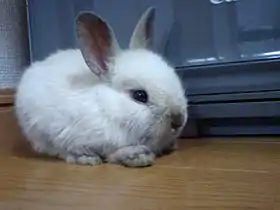
(Netherland Dwarf breed)
Small rabbits
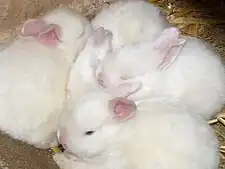
Blue-eyed white - Satin coat
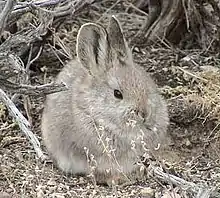
The Netherland Dwarf is the smallest of the domestic rabbits. The American Rabbit Breeders Association (ARBA)[3][4] accepts a weight range of 1.1–3.5 kg (2.4–7.7 lb), but 2.5 kg (5.5 lb) is the maximum allowed by the British Rabbit Council (BRC).[5] The small stature of the Netherland Dwarf was initially the result of the dwarfing gene: dw. Its short neck and rounded face are additional features of neoteny.
Many small rabbit breeds have the dwarfing gene, but the Polish and the Britannia Petite are among those that do not. They have attained their small stature solely through selective breeding of successively smaller generations (a processing called dwarfing).
Some small rabbits (often mixed breeds) are a false dwarf, a rabbit that did not inherit the dwarfing gene.
One of the smallest species of wild rabbit is the Marsh rabbit (Sylvilagus palustris), an excellent swimmer[6] that weighs 2.2–2.6 kg (4.9–5.7 lb).
Smallest rabbit breeds
The following table includes rabbit breeds currently recognized by ARBA[3][4] or by the BRC[5] that have a maximum weight of 4 kg (8.8 lb). Also included is a small breed from Germany, the Teddy Dwarf.[7]
| Breed name | Image | Weight | Ear type |
|---|---|---|---|
| Netherland Dwarf | 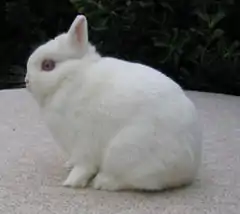 | 1.1–2.5 kg (2.4–5.5 lb) | erect |
| Britannia Petite [US] |  | 1.5–2.5 kg (3.3–5.5 lb) | erect |
| Teddy Dwarf Also called: Teddyzwerg | 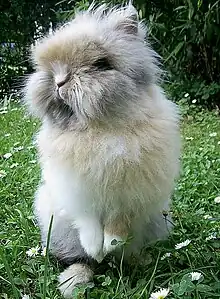 | 0.8–1.7 kg (1.8–3.7 lb) | erect |
| Dwarf Hotot | 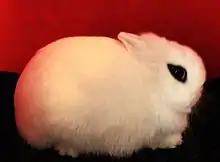 | 2–3 kg (4.4–6.6 lb) | erect |
| Jersey Wooly | 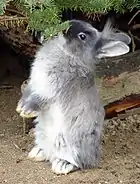 | 2.5–3.5 kg (5.5–7.7 lb) | erect |
| Polish [US] |  | 2.5–3.5 kg (5.5–7.7 lb) | erect |
| Lionhead [UK] |  | 1.36–1.7 kg (3.0–3.7 lb) | erect |
| Miniature Lion Lop | 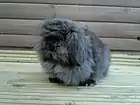 | 1.5–1.6 kg (3.3–3.5 lb) | lop |
| Miniature Lop [UK/NL] |  | 3.4–3.8 kg (7.5–8.4 lb) | lop |
| Miniature Cashmere Lop |  | 3.5 kg (7.7 lb) | lop |
| American Fuzzy Lop | 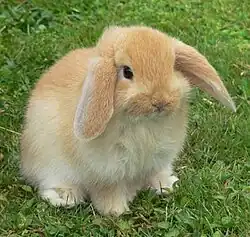 | 3.5–4.0 kg (7.7–8.8 lb) | lop |
| Plush Lop (Miniature) |  | 1.7–1.8 kg (3.7–4.0 lb) | lop |
See also
References
- Hu, Dou (May 2014). "Identification and analysis of the dwarf mutation in domestic rabbits (Master's Thesis)" [Identifiering och karaktärisering av dvärg mutationen hos tamkaninen] (PDF). Examensarbete. 444. Uppsala: Swedish University of Agricultural Sciences - Department of Animal Breeding and Genetics: 1–26. Retrieved 19 February 2018.
{{cite journal}}: Cite journal requires|journal=(help) - Fiorello, Christine V.; German, R.Z. (February 1997). "Heterochrony within species: craniofacial growth in giant, standard, and dwarf rabbits". Evolution. 51 (1): 250–261. doi:10.1111/j.1558-5646.1997.tb02406.x. PMID 28568789. S2CID 205780205.
- Standard of Perfection 2016-2020. American Rabbit Breeders Association. 2015. ASIN B018GVBJK4.
- "ARBA Recognized Breeds". American Rabbit Breeders Association. Retrieved 19 February 2018.
- "Breed Standards 2016-2020" (PDF). British Rabbit Council. Retrieved 29 January 2018.
- Compton, Gail (29 September 2012). "Swimming Rabbit Surfaces". No. Lifestyle. The St Augustine [Florida] Record. Retrieved 22 February 2018.
- "Herzlich Willkommen auf den Webseiten des Teddykaninchen-Clubs". Teddykaninchen Club. Retrieved 22 February 2018.